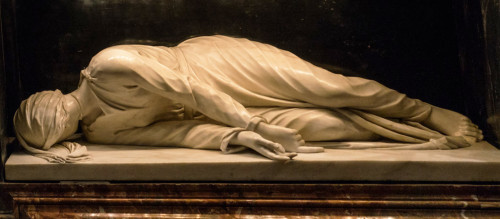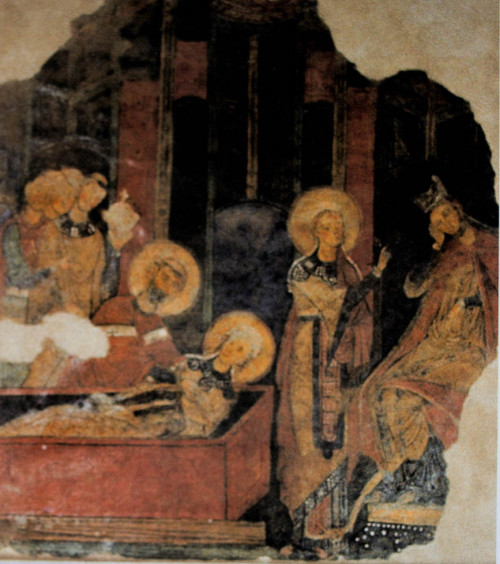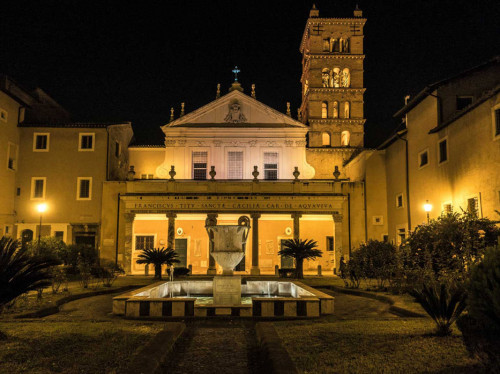Stefano Maderno’s Lying St. Cecilia – a miracle or an elaborate mystification?

St. Cecilia, Stefano Maderno, altar of the Church of Santa Cecilia

St. Cecilia, Stefano Maderno, Church of Santa Cecilia

Stefano Maderno, statue of St. Cecilia, fragment, Church of Santa Cecilia

Pope Paschal's dream - finding the body of St. Cecilia, fresco from the 13th century, Church of Santa Cecilia

The facade of the Church of Santa Cecilia in Trastevere
The eyes of a person approaching the apse of the Church of Santa Cecilia on the Roman Trastevere will immediately wander to the snow-white statue of a lying woman. Her body is placed sideways, while her head is turned away from the onlookers. When we move in closer, we will notice a narrow slash on her neck and hands clasped together as if wanting to express something, which cannot be guessed. Such a sculpture had not been seen in Rome before, so it is no surprise that throngs of people admired the statue paying an almost divine homage to it. But was it a sculpture, or perhaps Cecilia herself, miraculously brought back to life in all the beauty of her youthful age?
The eyes of a person approaching the apse of the Church of Santa Cecilia on the Roman Trastevere will immediately wander to the snow-white statue of a lying woman. Her body is placed sideways, while her head is turned away from the onlookers. When we move in closer, we will notice a narrow slash on her neck and hands clasped together as if wanting to express something, which cannot be guessed. Such a sculpture had not been seen in Rome before, so it is no surprise that throngs of people admired the statue paying an almost divine homage to it. But was it a sculpture, or perhaps Cecilia herself, miraculously brought back to life in all the beauty of her youthful age?
Shortly prior to another Jubilee Year (1600), the Eternal City was besieged by an enormous flood and a deadly epidemic, which was perceived as a sort of dispensation of providence. Another event that made waves in the city on the Tiber was the death (11 September 1599) of the twenty-two-year-old patricide Beatrice Cenci, who was accompanied by throngs of Romans to the place of her death. Despite her unquestionable guilt, people felt great sympathy towards the young woman, while also giving rise to a wave of criticism against the severe and ruthless judge Pope Clement VIII. When a month after this execution another beautiful woman appeared, this time of unblemished morality, the Roman populace once again took to the streets and directed its steps towards the Trastevere, where, in the local Church of Santa Cecilia a miracle occurred. It concerned a woman, who according to a legend, died a martyr’s death in the III century in this very location. The titular cardinal of the church, Paolo Camillo Sfondrati, had for some time been conducting modernization works in the church, preparing it for the upcoming Jubilee Year, which was always celebrated with great fanfare. Hundreds of thousands of pilgrims were expected desiring to visit holy places and churches dedicated to martyrs, among which the one connected with the cult of Cecilia was also included. After opening her cypress coffin it turned out that the body of the young martyr is in an impeccable state, untouched by decomposition. If that was not enough, marks of the sword were still present upon her neck. She looked as if she had just been slain and laid in a grave. Let us remind ourselves that the translation of Cecilia’s body to this place was carried out by Pope Paschal I in the year 822; it was then that her relics were laid to rest under the floor of the church on the Trastevere. This is what iswritten in the Liber Pontificalis. This text which was key to the history of the Church, the most important source of information about popes and churches, said nothing about the condition of the corpse, however, it did say that the skull of the saint was taken out by Paschalis and placed in a silver reliquary. Then it was gifted by Pope Leo IV to the Church of Santi Quattro Coronati, which is testified to by the inscription found under the altar. Other remains also had to be taken out of the coffin, since they came into the possession of the Roman Church of San Luigi dei Francesi (e.g. the arm), but also of the French city of Albi – a place of particular veneration of Saint Cecilia.However, let us return to the year 1599. After the discovery of the sarcophaguses of Cecilia and other martyrs (her husband Valerian, brother-in-law Tiburtius, a converted Roman official Maximus, and two popes Urban I and Lucius I) on the Trastevere, a papal delegation arrived at the church, followed by the pope himself. The saint's remains were inspected with the proper respect. Written testimonies of two officials and friends of cardinal Sfondrati, who participated in the examination, Cardinal Cesare Baronio, and the antiquarian Antonio Bosio are rather enigmatic. Baronio writes nothing about the saint's head, while Bosio notes that in reality, he saw a chest with the dimensions of 135 x 34 x 45 cm, inside which was the saint covered in silk fabrics. They both believed that they had seen a human figure, although the antiquarian was surprised by the size of Cecilia’s body (approximately 124 cm), which Bosio attributed to the shrinking of bones (?). The relics were shown in the closed room of the church sacristy for a month, while during that time cardinal Sfondrati celebrated mass daily by the saint’s corpse, then the coffin was once again placed below the altar (22 November) during a solemn mass celebrated by the pope. That day the Trastevere attracted crowds of people – aristocrats, ambassadors, representatives of the Senate, but above all the Roman populace. In order to keep the situation under control, the Swiss Guard had to intervene. Bosio, who reported these events, points out the girls and Roman matrons who suddenly found their patron and intercessor in Cecilia. He also describes miraculous cures which occurred during the ceremonies and which in turn convinced people to leave numerous votive offerings.

Several weeks later (16 December) directly under the church altar, in a niche laid out with dark blue marble reminiscent of a coffin, a sculpture of Saint Cecilia appeared, completed by a young, unknown in Rome artist – Stefano Maderno. It was to represent the deceased at the moment of being discovered by cardinal Sfondrati. Maderno was probably not aware of the fact that he had just created his best work, one which would make him famous for centuries to come. We can only imagine the exclamations of admiration, deep sighs, and the sobbing of those who laid eyes upon the saint’s statue, a girl murdered in a barbaric way centuries ago and in a miraculous way discovered many centuries after. This was no sculpture, this was the live Cecilia, with a body that was cold, not due to the stone from which it was made, but because of the visible death. Until now such sculptures had not been seen in churches. It was veiled in a mysterious aura and a dramatic overtone. Situated in the central point of the church, in a lying position, it seemed – and this was the most striking – real as if the young woman had just been killed. Turning Cecilia’s head away from the onlooker, the artist left him with contemplation of the delicate limbs dressed in a silk fabric with marks of swords upon her neck. Three wounds (two barely visible) related to the saint's martyrdom. The executioner had tried three times to end her life but did not succeed, and the girl had actually died three days later due to blood loss. Maderno presented Cecilia in a veil covering her head, reminding of her virginity, while her body was covered with a simple tunic, showing off her limbs, neck, leaving the hands and feet bare. The statue most likely created with the aid of Sfondrati, an art collector and enthusiast was not only a perfect image of the deceased, but it also provided a very important message. When we look upon the three wounds on Cecilia’s neck, but most of all upon her three straightened fingers, we can see a gesture that reminds the viewer of the Holy Trinity.
Those who would not believe the miracle on the Trastevere was legit were quickly silenced, when cardinal Sfondrati had an inscription placed below the statue in which (speaking to the Creator) he ensured Him that it is an authentic image of the saint, whom he himself had seen, as she lay untouched in her grave, and which he then had sculpted in marble. Why was such a mystification allowed when the information contained in the Liber Pontificalis was widely known? In order to respond to this question, we must understand the situation of the Church just prior to the Jubilee Year.
The ambitious, removed from power after the death of his uncle Pope Gregory XIV, cardinal Sfondrati and his friends (Cesare Baronio, Antonio Bosio), along with other people from those surrounding Clement VIII saw in the celebrations of the Jubilee Year an opportunity for a new opening of the Church in the spiritof the Counterreformation and the agreements of the Council of Trent. The newly rediscovered body of Cecilia fit in perfectly with this policy. It reminded all Catholics, that the Roman Catholic Church – drawing its strength from the martyr's death of Cecilia (and many other martyrs) – is the only religion that guarantees their salvation, while the pope is the only leader of the Church in the world. Relics of saints and the places of their keeping were to be newly treated with the highest respect. They were also newly attributed miraculous powers and increasing the belief that their smallest part or even their proximity is a cure for all evil. In opposition to Protestants who ridiculed the saints with their fable-like lives and considered the cult of their relics a superstition, Catholic art was to recall the martyr saints and refer to the feelings of the viewer, stimulating deep emotions and empathy. It was to be uplifting and constitute a sort of catharsis, but at the same time introduce the value of spirituality and above all miraculousness. Even during the pontificate of the previous pope, Sixtus V, the Church returned to the great tradition of early Christianity, recalling – as the most glorious – the times of Pope Damasus I, who lived in the IV century. The position of Rome as the capital of Christianity was once again accentuated, while also emphasizing that the land it stands on is filled with the blood of martyrs, and in places of their death or cult the Eucharist was being celebrated, often by the pope himself. Processions, grand religious ceremonies, pilgrimages were once again in fashion, religious brotherhoods developing devotional practices and charity work were being established. “The saints are among us, while their bodies are found in divine power, which has nothing to do with the earthly mind” – that is what the figure placed in the church on the Trastevere seemed to be saying. The sculpture of Cecilia became a living relic – proof that the body can be wholly preserved after death, which showed that resurrection is possible. It of course went completely against what the Church had practiced until that time of separating relics into pieces (skulls, fingers, arms, feet) which could be found in churches all around Europe and even elsewhere.
And that is the path that subsequent artists of the XVII century will follow. Art will emanate with the pain of the murdered martyrs, show their determination, encourage prayer, and arouse fear. However, it will also express something more, something thoroughly romantic and modern at the same time – respect which intertwines with empathy, just as death intertwines with sleeping, and reality with miracle.
If you liked this article, you can help us continue to work by supporting the roma-nonpertutti portal concrete — by sharing newsletters and donating even small amounts. They will help us in our further work.
You can make one-time deposits to your account:
Barbara Kokoska
BIGBPLPW 62 1160 2202 0000 0002 3744 2108
or support on a regular basis with Patonite.pl (lower left corner)
Know that we appreciate it very much and thank You !

